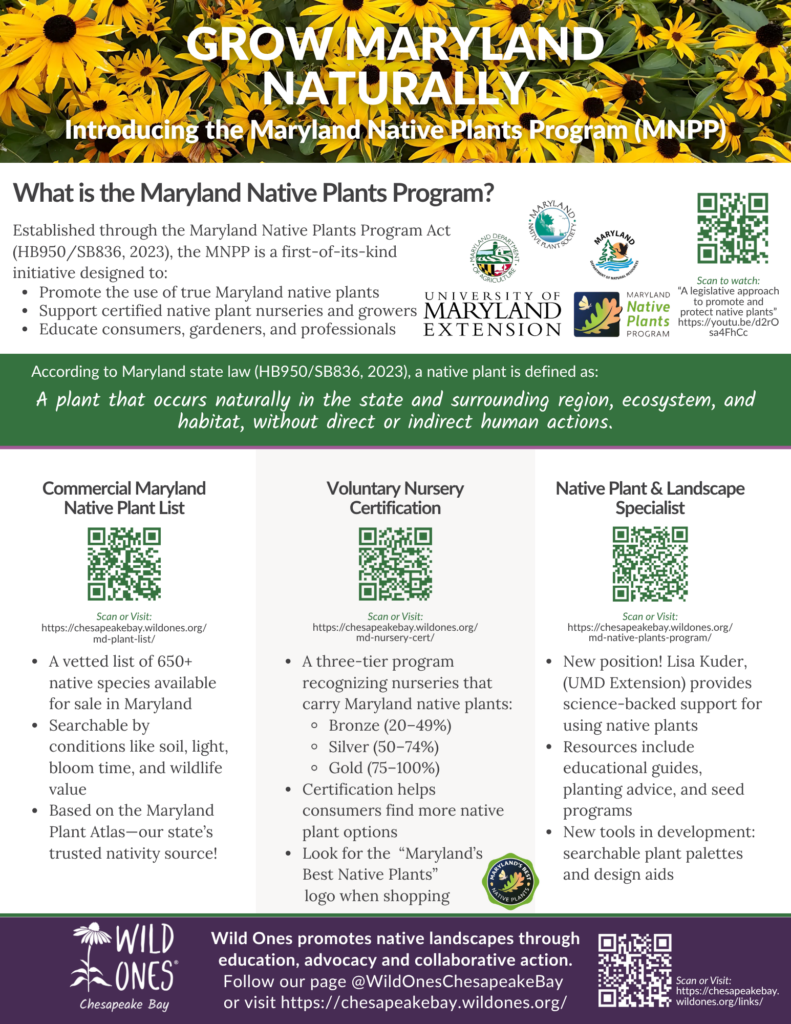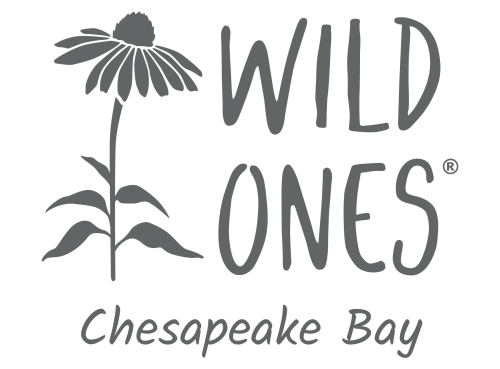What may be the first program of its kind in the nation, the new Maryland Native Plants Program (MNPP) is now live. Developed through legislation ((HB950/SB836) passed in 2023 and effective July 1, 2024, the MNPP aims to bring more awareness about the benefits and importance of Maryland native plants to consumers, encourage consumers to purchase Maryland native plants from authorized retailers, and encourage retailers to carry more plants in their inventory and participate in voluntary certification. The MNPP is a new partnership between
- University of Maryland Extension (UME)
- Maryland Department of Natural Resources (MD DNR)
- Maryland Native Plant Society (MNPS)
- Maryland Department of Agriculture (MDA)
The three main components of the MNPP include:
- Commercial Maryland Native Plant List (CMNPL) derived from natives listed on Maryland Plant Atlas
- Voluntary nursery certification program administered by Department of Agriculture’s Maryland’s Best Program
- New University of MD Extension position: Native Plants and Landscape Specialist
Commercial Maryland Native Plant List (CMNPL)
The Commercial Maryland Native Plant List is a living document in spreadsheet format and is a dependable source for what’s native throughout the State and which plants are best suited for different growing conditions. According to the legislation passed in 2024, “native plant means a plant that occurs naturally in the state and surrounding region, ecosystem, and habitat, without direct or indirect human actions. It includes a plant that was present before colonial settlement or is listed as native to Maryland on the Maryland Plant Atlas website.”
The CMNPL includes approximately 650 plants native to Maryland’s three main ecoregions – mountains, Piedmont, and coastal plains – and will grow as new species are submitted that meet the criteria of a Maryland native plant and are sold in the trade.

Image source: Commercial Maryland Native Plant List | University of Maryland Extension
How were species selected for the CMNPL? An Advisory Committee that includes partners from the MNPP and industry representatives, specifically Maryland growers and retailers, created a list of natives sold, then vetted each species. While multiple resources are used to determine nativity, the Maryland Plant Atlas, managed by the Maryland Department of Natural Resources in collaboration with UMD’s Norton-Brown Herbarium, and Maryland Biodiversity Project, serves as the definitive source.
A review of the CMNPL shows a spreadsheet with multiple tabs. You can view:
- Alphabetical lists of plants by plant type or by scientific name
- Plant specific tabs (wildflowers, ferns, grasses/sedges/rushes, trees/shrubs, woody vines)
- Sources
- Excluded species
Plant characteristics for each species are quite comprehensive, including region, light, moisture, soil, size, bloom time, flower color, fall foliage, winter interest, wildlife value, and tolerance to a variety of environmental conditions. Detailed information on natives excluded, uncertainty nativity, and cultivars is summarized on the UME Commercial Maryland Native Plant List webpage.
Coming soon…. Coefficients of Conservatism (C-Values) for Maryland are currently under development. As they are determined, C-Values for Maryland will be added to the “Growth” column in stages over the next several months. For a look at C-values for Virgina, check out the C-Valures for the Flora of Virginia.
Voluntary nursery certification program
By certifying retailers through a voluntary application process, the MNPP aims to make it easier for consumers to find Maryland native plants through use of a logo created for retailers who become certified. How does it work? Any Maryland native plant retailer, wholesaler or grower can participate. Nurseries near Maryland that have significant sales in Maryland are also allowed to participate. Nurseries fill out an online form listing how much of their total plant inventory is made up of straight species natives found on the CMNPL. The three certification tiers – bronze (20-49%), silver (50-74%), and gold (75-100%) – represent the percentage of Maryland native species compared to the total number of species. Additionally, the number of Maryland species offered is a good indicator of the diversity of species that each retailer sells.
Once certified, retailers may use the MDA’s Best Native Plants logo on plant tags and signage to make it easier for consumers to identify Maryland natives.

As of May 25, 2025, the list contained 25 growers/retailers. To find a retailer near you, visit Maryland Native Plants for Consumers for their list and interactive map.

Native Plant and Landscape Specialist
Education will be provided to both consumers and growers about the value of incorporating native plants in local gardens and landscapes under the leadership of Lisa Kuder, UME Native Plants and Landscape Specialist. The University MNPP Extension program supports the nursery industry and end-users by providing unbiased and research-based information about how to select, propagate, and use native plants in developed and natural landscapes. Projects currently in progress to support educational endeavors include:
- User-friendly tools based on the Commercial Maryland Native Plants List are under development with UMD iConsultancy student teams. The first tool will be a searchable database with user-defined printing options; and the second is an engaging, visual interface to help end-users build plant palettes by project type, i.e. a rain garden or sunny slope. Trial versions are anticipated in spring 2026.
- Full-colored regional plant guides are coming soon. The anticipated release date for the Piedmont plant guide is summer 2025. Guides will be available for free download, and hard copies available for purchase.
- Native seed program

Learn more about the Maryland Native Plant Program in a recent webinar presented by Kirsten Hoffman and Judy Fulton and hosted by Wild Ones Chesapeake Bay.

Frequently Asked Questions:
What is a native plant?
According to the legislation ((HB950/SB836) passed in 2023 and effective July 1, 2024, “native plant means a plant that occurs naturally in the state and surrounding region, ecosystem, and habitat, without direct or indirect human actions. It includes a plant that was present before colonial settlement or is listed as native to Maryland on the Maryland Plant Atlas website.”
What is the preferred resource for determining if a plant is native to Maryland?
As stated in the legislation, Maryland Plant Atlas is used for determining the native status of plants by the MNPP. Why? It is a searchable, online database that receives periodic updates. It includes plant species in natural areas, including all MD natives and naturalized non-natives. Used by the Maryland Department of Natural Resources, it is based on Knapp and Naczi’s 2021 scientific publication Vascular Plants of Maryland, a comprehensive text for botanists that includes all plants found in Maryland (both native and non-native). Organized by plant families, Vascular Plants of Maryland does not relate directly to what consumers see at nurseries (genus and species), and there is no online or searchable version.

